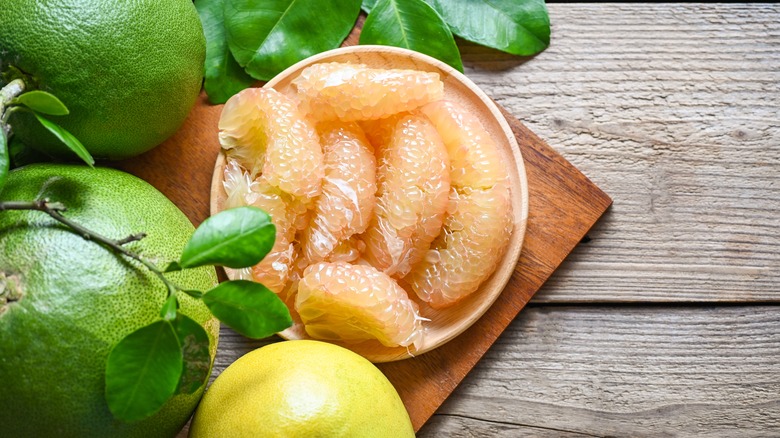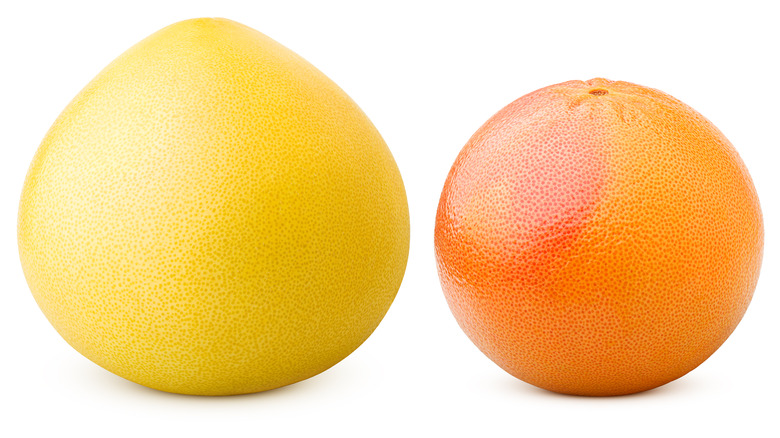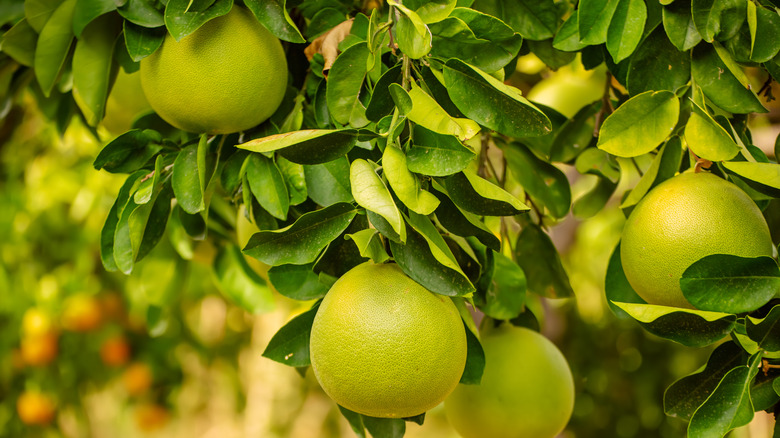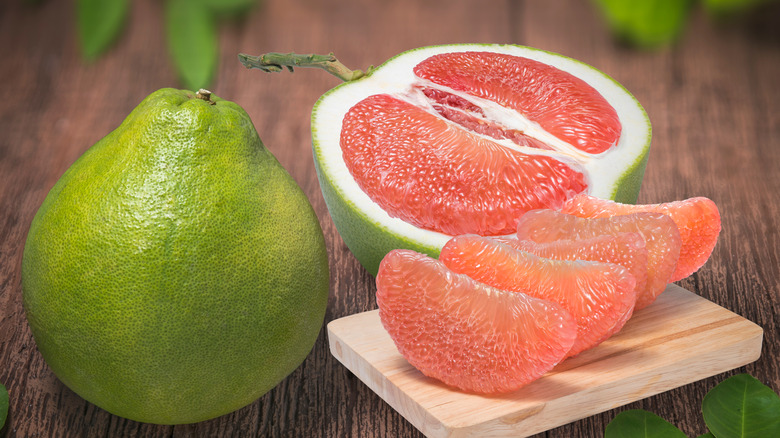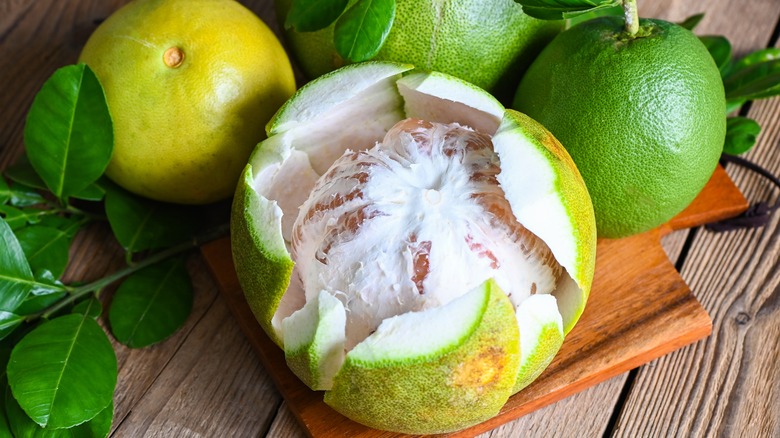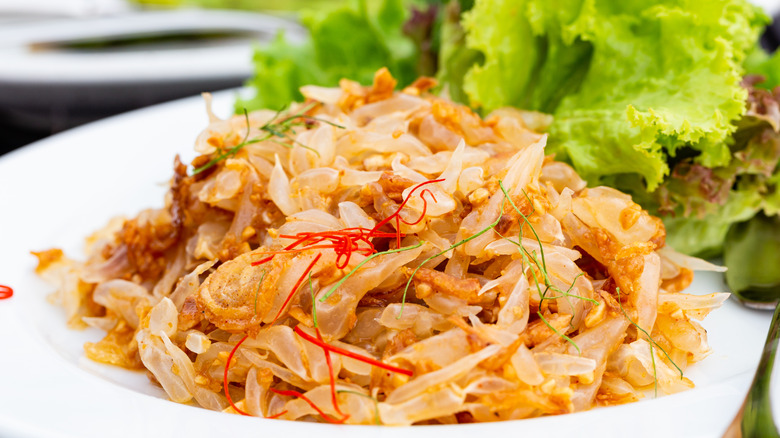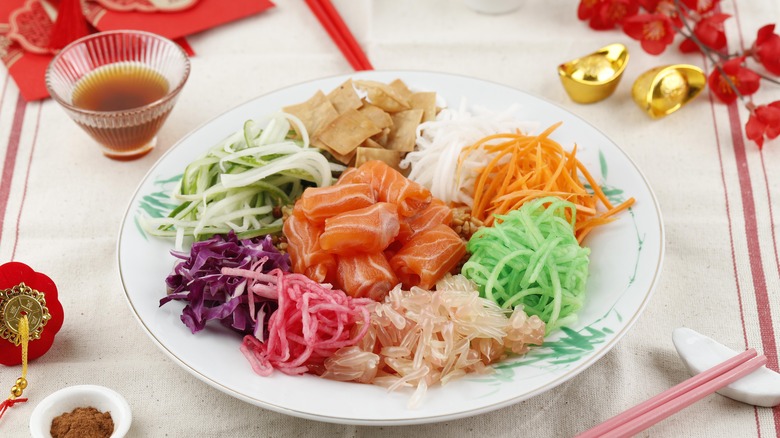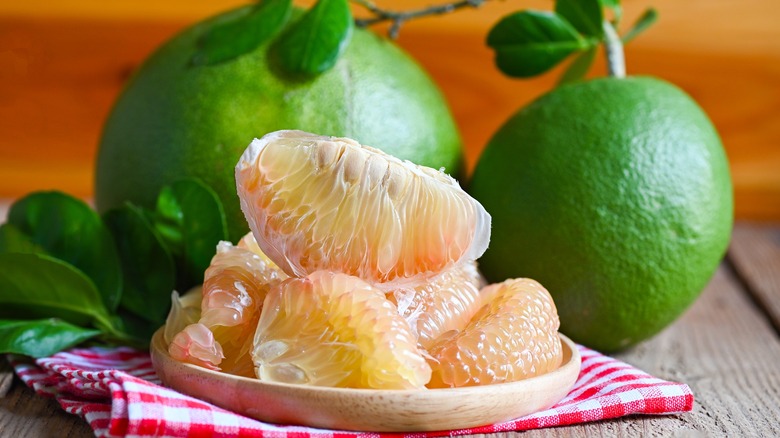What Is A Pomelo Fruit, And How Is It Different From Grapefruit?
There are so many different types of citrus fruits, but the pomelos, also called pummelo, Chinese grapefruit, shaddock, Pamplemousse, or jabong, are one of the most important. Pomelos look like supersized grapefruits, and they come in a pretty gradient with the outside ranging from yellowish green to light lime green. The inside can vary from white to pale yellow or faint to bright pink. They are a bit oblong — roundish in shape but usually flat-bottomed.
The scientific name for the pomelo is Citrus maxima. Pomelos belong to the Rutaceae family along with all plants in the citrus genus. The pomelo is one of the three OG citrus fruits, along with citrons and mandarins, from which all others descend. Some of these hybrids have occurred naturally while others were made intentionally by humans. Sweet and sour oranges, for example, are a natural hybrid between a pomelo and mandarin. The sour orange crossed with a mandarin makes a tangerine. The tangerine crossed back with the pomelo makes the tangelo. Even uniquely flavored Meyer lemons, and, yes, grapefruits, would not exist without the pomelo.
What's the difference between a pomelo and a grapefruit?
Some refer to a pomelo as a cousin of a grapefruit, but it is more a grandparent. Grapefruits came from the Caribbean where a pomelo naturally crossed with an orange. Early grapefruits were unpalatable but were bred to be tastier and contain fewer seeds. Pomelos have a similar but lighter flavor than their grapefruit descendants. They still have a tartness, but they lean more sweet than bitter and acidic. You can use the fruits interchangeably, but opt for grapefruit when you want a punchier taste and pomelos when you want something milder. Grapefruits can also be a little juicier.
The largest difference between a pomelo and a grapefruit is well — the largeness. Pomelos are certifiably huge with a diameter ranging from 6 to 10 inches. The largest pomelo ever recorded was grown in Japan in January 2023. It weighed more than 12 pounds and had over a 10-inch diameter. Grapefruits may have a diameter of six inches at their largest.
The pith of the pomelo is very thick and springy. While the pith of grapefruit is considered thick compared to other citrus fruits, it is significantly thinner than that of a pomelo, which can be more than half an inch wide. The texture of the skin of both fruits is similar — nearly smooth with fine-grained dimples — but grapefruit skin can warm to shades of orange and pink. Both fruits have skin rich in aromatic oils.
Where do pomelos come from?
Pomelos probably first grew wild somewhere around present-day Malaysia, but they have been cultivated across Asia and Papua New Guinea for many centuries. They were first brought to China in approximately 100 B.C. and made it to the Caribbean in the 1600s. Aside from Malaysia, these days pomelos are commonly grown across southeast Asia in countries like Thailand, Indonesia, and the Philippines – though they are also grown in parts of the Americas that have suitably warm and wet tropical or subtropical climates. As such, pomelos are not grown on a large scale in the United States, and the only places that have had consistent success cultivating them are California and Florida, so you're most likely to find them in a farmer's market or specialty store.
Pomelo trees are evergreen and can produce fruit at different times of the year, depending on the climate. The trees are somewhat squat with shiny, deep green leaves, and dramatic white flowers. It does take around eight years for a pomelo tree to yield fruit.
What are the popular varieties of pomelo?
The majority of pomelos have white fruit, but there are also varieties that blush pink. While much of the fruit from different types of pomelos is tender and juicy, some can also be more pulpy and chewy – though tasty nonetheless. Certain varieties are tear-drop shaped while others or more spherical. Some are seedless, and some contain an abundance of seeds.
Tahitian pomelos, as the name suggests, are commonly grown across Polynesia, and have floral and lime notes. They are quite sweet, have pale yellow or white flesh, and the skin goes from green to warm yellow when they are ready to eat. Cuban Shaddock also have light-colored fruit but are much more acidic. Both African and Red Shaddock come from the African continent — African Shaddock fruit leans pink while Red Shaddock have a rich red color. Chandler pomelos, which have fruit that can be an ombre of pink, and Oro Blanco pomelos, which are lemon yellow inside and out, are both commonly found varieties in the United States.
In Asia, where pomelos are most commonly eaten, they are "known as limau besar, limau betawi, or limau serdadu in Malay; jeruk bali in Bahasa Indonesia; sam-o in Thai; lukban in Tagalog; and bu'o'i in Vietnamese," notes the National Library Board of Singapore.
How to pick and prepare a pomelo
Don't be intimidated by this giant fruit! If you've ever peeled an orange or cut a melon, you can dig into a pomelo. Look for weighty fruits with unblemished skin and a delicate aroma of bright citrus and pleasant florals. Citrus fruits have a long shelf life in general, and an uncut pomelo can last up to about a month when refrigerated.
Start by cutting both ends off the pomelo. Stand the pomelo upright on the flat surface you have now created, and using a sharp paring knife, cut into the rind and pith (but not the fruit) from top to bottom creating a deep score. Set the knife aside, and use your hands to remove the cut sections. At this point, you should be able to split the pomelo in half. Use your fingers to peel off as much of the bitter white pith as possible from each segment. If the pomelo has a particularly stubborn pith, you can use your knife to pry the pith away from the flesh of the fruit.
If you want to cut this citrus fruit into tender, juicy, supremes, start by using a very sharp knife to cut off the top and bottom so that the fruit is revealed. Cut down vertically, following the curve of the fruit removing all the rind and pith, like you are peeling a whole pineapple or watermelon. Once the segments are revealed, hold the peeled pomelo in your hand and cut out each segment carefully.
How to eat a pomelo
Of course, pomelo is a great fruit to eat on its own, but you can also enjoy pomelos anywhere you would use fresh citrus when you want a delicate, tangy, and sweet taste. Sometimes they are not quite as juicy as other citrus fruits, so you may need to combine pomelo juice with another type of citrus to get an amount you could use in a glaze, vinaigrette, or marinade. The fresh fruit is delightful in salads, both sweet and savory, and as a topping on desserts. The rind can be cooked down in a sugar syrup to candy it — or turned into marmalade.
Yum som-o is a Thai dish that combines chunks of juicy pomelo segments with peanuts, coconut, shallots, dried shrimp, chilies, and lots of fresh herbs like cilantro, kaffir lime leaves, mint, and lemongrass. The salad is dressed with zingy palm sugar, lime juice, and fish sauce vinaigrette. A typical Cantonese preparation of pomelo utilizes the skin. The outside of the rind is charred and scraped clean. Pieces of the rind and pith are dunked in cool water, squeezed, and wrung out multiple times to temper the bitterness. They are then braised in an aromatic broth and accompanied by ingredients like shrimp roe, dried shrimp, sliced pork, oyster sauce, abalone, or soy sauce.
Why are pomelos eaten on Chinese New Year?
Chinese New Year is a time when everyone is gathering as much good luck as they can for the year to come. Food, family, symbolism, and superstition all come together to make for lots of fun — and tasty! — Chinese New Year traditions.
Pomelos are considered an auspicious food to eat because the word for pomelo in Chinese sounds very similar to the word "have." Eating pomelos means that you will "have" an abundance of good things like joy and prosperity. The scent of pomelos is said to deter bad luck, and the leaves or rind can be used to make an infusion for a bath that purifies and protects.
Avoid setting out pomelos in the amount of four. The number four sounds close to the word for death and is considered very unlucky in Chinese culture. Cut up fruit platters are the typical dessert after a Chinese New Year's meal. Fruit is considered a delicacy and a demonstration of hospitality. Pomelos might be served alongside other auspicious fruits like apples – representing peace — and dragon fruit and starfruit to usher in good luck. "Golden-hued fruits like oranges, tangerines and kumquats are believed to bring wealth to those who eat them, their gold colors reminiscent of money," reports The New York Times. Pomelos can also be used in the Chinese New Year dish yu sheng, a vibrant and artfully displayed salad of fruits, vegetables, and raw fish commonly served in Malaysia and Singapore.
What are the health benefits of pomelos?
In traditional Chinese medicine, different parts of the pomelo fruit and plant are eaten or used to create salves, syrups, lotions, and teas. Pomelo products have been used to treat coughs, asthma symptoms, sinus issues, and indigestion. The leaves can be used to make a soothing lotion that those in Malaysia sometimes use for skin conditions or ulcers.
Pomelos, like all citrus fruits, are rich in vitamin C as well as potassium. In fact, a single pomelo can have more than 400% of the targeted daily consumption of vitamin C. An average pomelo also boasts five grams of protein and six grams of fiber, making this fruit not only mineral- and vitamin-rich but also a snack that keeps you full and satiated. Pomelos are a great source of antioxidants that can help promote heart health, reduce inflammation, lower bad cholesterol, and promote overall gut health (per Healthline). You really can't go wrong with a refreshing and delicious pomelo — whether you eat it straight out of the rind or incorporate it into a dish.

